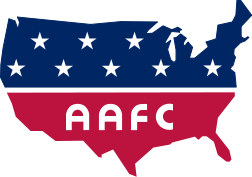September 06, 2011
 It was called the World Series of Football, but in reality it was supposed to be a joke. To be honest, it was a set-up. In the game that opened the 1950 season, the big, bag Eagles of the big, bad NFL were supposed to dominate the pass-happy Cleveland Browns of the recently-defunct All-America Football Conference. Nobody thought a team from the AAFC could compete with an NFL team, especially the NFL team that had one the league title for the past two seasons. All Cleveland’s coach Paul Brown wanted was a chance to play against an NFL team. And on September 16, 1950, he finally got that chance.
It was called the World Series of Football, but in reality it was supposed to be a joke. To be honest, it was a set-up. In the game that opened the 1950 season, the big, bag Eagles of the big, bad NFL were supposed to dominate the pass-happy Cleveland Browns of the recently-defunct All-America Football Conference. Nobody thought a team from the AAFC could compete with an NFL team, especially the NFL team that had one the league title for the past two seasons. All Cleveland’s coach Paul Brown wanted was a chance to play against an NFL team. And on September 16, 1950, he finally got that chance.
In 1944, Arch Ward (the same Arch Ward who invented MLB’s All-Star Game) founded the All-America Football Conference, which would have its inaugural season in 1946. Unlike other competing leagues, the AAFC had a real chance to unseat the NFL as the preeminent professional football league in America. It’s owners were richer than NFL owners. Ward, the sports editor at the Chicago Tribune, would ensure that the AAFC would receive ample media coverage. With air travel’s rising viability, the AAFC placed franchises from Florida to California, while the NFL was stuck in the Northeast. And importantly, they had talent: it’s ’46 rosters included 40 of the 66 College All-Stars, 2 recent Heisman Trophy Winners, and over 100 players who had played in the NFL.
Not surprisingly, the NFL’s view of the AAFC and its teams wasn’t very positive. It was referred to as a “cheese league.” It was laughed at. During the advent of the league, Redskins owner George Marshall said “I did not realize there was another league, although I did receive some literature telling about a WPA project.” He also bluntly voiced what most NFL guys thought: “The worst team in our league could beat the best team in theirs.” This type of talk fueled a war of words between proponents of the two leagues, but because there were no interleague games, the debate was never settled.

Though there was talent in the AAFC, it was concentrated at the top of the league. While those teams were successful, the majority of teams were not. The talent gap caused many teams to go into the red. And even though the AAFC enjoyed higher attendance than the NFL, the league’s debt ultimately lead to its downfall after the 1949 season. After that season, the three successful teams from the defunct league, the Cleveland Browns, the San Francisco 49ers and the Baltimore Colts, merged into the NFL.
The merger finally allowed AAFC teams and NFL teams to compete. Taking full advantage, NFL commish Bert Bell (who had an unsuccessful run as Eagles coach from 1936-40) elevated opening day of the 1950 season into the “World Series of Football” by pitting the Philadelphia Eagles against the Cleveland Browns. The Eagles were the class of the NFL, having won the championship in ’48 and ’49. The Browns were far and away the best team in the AAFC. Under coach Paul Brown, they won the AAFC title in each of the league’s 4 years of existence and went 47-4-3 during that span. However, they didn’t get any respect from the NFL establishment. They were merely a big fish in a small pond; a little brother compared to the real teams of the NFL. By scheduling them against the Eagles, Bell looked to put the Browns in their place and prove once and for all that NFL talent trumps AAFC talent.

Earle "Greasy" Neale
Eagles coach Greasy Neale held little regard for the Browns, or any other team for that matter. Prior to the season, Neale was as confident in his team a certain backup quarterback is in his, “This is the best team ever put together, who is there to beat us?” And with players like Tommy Thompson, Pete Pihos, Steve Van Buren, and Chuck Bednarik, nobody really called into question Neale’s arrogance.

Paul Brown
However, the Browns were stacked with talented players too. Seven players would be enshrined in the Pro Football Hall of Fame: quarterback Otto Graham, wide receiver Dante Lavelli, fullback Marion Motley, center Frank Gatski, kicker Lou Groza, and defensive linemen Bill Willis and Len Ford. But more than the players, the Browns had a coach. Paul Brown was an innovator whose legacy changed the NFL forever. Just to name a few of the things that Brown did before anyone else:
Even with those players and even with that coach, because the Browns played in the AAFC, the Eagles were favored on all accounts. Prior to the game, Paul Brown said, “The Eagles may chase us off the gridiron, but we’ll be on hand for the game with no alibis…Truthfully, I don’t know what to expect tomorrow night. We have been told the Eagles out class us, but we will be on hand.”
On hand they were. From coaching to kicking, the Browns absolutely dismantled the Eagles in every aspect of the game. And they did so in front of 71,000+ fans at Philadelphia Municipal Stadium, a record for the largest home crowd for a regular season game that still stands.

Marion Motley and his Chuck Taylors
Philadelphia got on the board first with a field goal. However, it didn’t take long for the Eagles players to realize that they were the ones in over their heads, not their counterparts from the AAFC. The Browns aerial attack, developed by Brown and orchestrated by Graham, was more sophisticated than that of any team in the NFL. A 59-yard touchdown pass from Graham to Dub Jones gave the Browns a 7-3 lead. On the ensuing drive, the Eagles marched right down the field to a first-and-goal at the Cleveland 6. Knowing there wasn’t any room to throw, Paul Brown subbed in his monstrous fullback Marion Motley as a middle linebacker. Motley stuffed three straight runs to contribute to a debilitating goal-line-stand and the Eagles morale quickly sank.
Graham gave the Browns a 21-3 lead on touchdown passes to Dante Lavelli and Mac Speedie, and then punched in a 1 yard touchdown run to put the game well out of reach. The final score was 35-10, but to most observers, that score didn’t reflect how dominant the Browns really were. Graham threw for 346 yards and 3 TDs while the Browns defense stifled the Eagles, holding the defending NFL champions to less than 250 total yards.
The New York Times described the game as follows:
Certainly, the beautifully coached Browns, with Otto Graham, as great as he ever was at Northwestern and since he became a professional, leading the attack, Greasy Neale’s Eagles were made to look bad. The Eagles’ defense against Graham’s passes was woefully weak, even if they managed to minimize the Cleveland trap plays, featuring Marion Motley. Graham went overhead thirty-eight times and completed twenty-one, good for 346 yards and three touchdowns. His was a magnificent display of aerial artistry and his was a job so well done that the difference between the elevens was greater even than the actual margin.
After the game, the Eagles players were reserved. Tackle Bucko Kilroy said, “It was no upset. Man for man, they were just a better team.” Greasy Neale wasn’t gracious in loss and instead criticized Brown, saying “he’d be a better basketball coach because all he does it put the ball in the air.” Paul Brown, not one to respond verbally, instead let his team answer Neale’s criticism: When the Eagles and Browns next met, the Browns beat the Eagles 13-7 without one official pass attempt.
Fans of the Eagles today hardly ever go into games with unshakable confidence that we are going to walk away with a victory. No matter how much better we are than our opponent on paper, there’s always that voice in the back of our heads rifling off the “what ifs” and the “buts.” From what I can tell, that voice was born on September 16, 1950.
Click here for an NFL Films piece on the game, ranked as the 4th biggest upset in NFL History.

